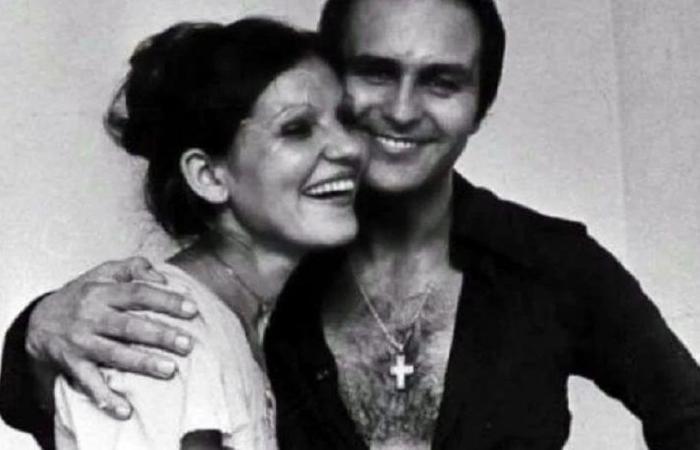
The love story between Leonardo Favio and Maria Vaner It is one of the most brilliant and remembered in Argentine cinema. They met in 1957 during the filming of The Kidnapper and they met again in 1959 while filming In the burning darkness. However, the romance did not blossom until the end of this last film, when they met at the same hotel during the International Film Festival in Mar del Plata.
At that moment, Favio, captivated by Vaner, lied to him saying that he was a film director and that he was going to film his first film. This lie had a powerful reason: he had fallen madly in love with her. Despite this small fallacy, the romance between them made them one of the most intense and emblematic duos of that time in our country. The couple not only shared their personal life, but also their passion for cinema. At that time, that young actress became a muse and constant inspiration for him, who directed her in his first films.
Favio, 21, was known for his explosive character and informal style; Vaner, 24, was an intellectual about to end an affair with Sergio Renan, with whom he had frequent arguments and began to suffer episodes of lipothymia. In The KidnapperMaría and Leonardo starred passionate scenes that left a deep mark on the protagonist. He even confessed to having become overly excited during a scene on a coffin.
Living together was a turning point for both of them. Maria deeply influenced Favio, bringing him closer to Vivaldi’s music and literature. Despite having only completed the second grade of Primary, Leonardo proved to be a self-taught person with great intuitive talent. Together they began to imagine what would be Chronicle of a lonely child, a film that he directed in 1965, marking his consecration as a director. Vaner was at his side in this and his next film, Aniceto’s romance and Francisca. During that time, they had two children: Luis and Leonardo.
The relationship deteriorated when Favio, immersed in preparing the script for Juan Moreirasuffered a tranquilizer overdose. At that time, the couple lived in Montevideo and Santa Fe, in the Federal Capital, and decided to separate: the director was deeply affected. In his grief, he began to compose and sing, dedicating the famous song to Mary. She forgot me. Before he had called her: Maria, there is no war and you are mine, according to the journalist Nestor Romano in his book Anecdotes from show business.
“She, she already forgot me. I, I remember her now. It was, like spring. Her dark hair. Her voice does not forget the kiss. And by the sea, the fever. That took me deep inside her. And we dream of children. That stole the beach from us. She, she already forgot me, eh, eh. I, I can’t forget her. “I… I can’t forget her…” It is part of the melody that continues to play from its release in 1968 to the present.
María, for her part, sought solace in the bohemian atmosphere of the hippie bars and met Marian Skubin, a Yugoslavian model. However, that relationship also ended in the midst of a deep depression that led her to be admitted to a clinic. Favio, meanwhile, found brief solace in Elsa Danielto whom he dedicated the song Elsita. That woman was also dealing with her own emotional problems after her breakup with the director. Rodolfo Kuhn.
In September 1967, Leonardo Favio met Carola Leyton in a candy store in Buenos Aires. The young woman from La Plata agreed to go out with him and, that same night, they sealed their destiny together. Carola gave Favio two more children: Nicholas and Maria Salomeand was by his side during the most difficult times of his life, including years of censorship and bans for his political beliefs.
That same year, the artist directed his third film, Dependent, a work acclaimed for its ascetic style and its simple but profound narrative. Seven years passed before he managed to film Juan Moreira (1973) and then Nazareno Cruz and the wolf (1975).
Some time before, in 1968, his musical career took off with hits like you were mine one summer and I want to learn by heart. Despite his popularity as a singer, Favio never abandoned his true passion for cinema. Between 1975 and 1976, he directed Dream… dreamconsidered his least accomplished work.
After the military dictatorship, Favio triumphantly returned to the cinema with Gatica, The Monkey (1990), considered his masterpiece. Although he occasionally performed as a singer, Leonardo preferred to seclude himself in his house, which he used to call his “bunker,” located on Pasteur Street. In 1993, he married Carola in a civil ceremony on Uruguay Street, with her children present.
Vaner, for his part, had a career marked by ups and downs and failed love relationships. Despite her efforts in film and television, she could not match the brilliance of her early years nor the sustained success of her sister. Norma Aleandro. Her relationship with Favio, full of love and conflict, was finally calmed down over the years, although that divorce meant a break in her career. Added to this was a death threat from Triple A, which forced her to return to Spain in 1974, where they were already for the same reason. Hector Alterio, Luis Politti and Marilina Rossamong other Argentines.
He returned to the country in 1983 and, the following year, starred in Heroic of Buenos Aires, by Osvaldo Dragún, he also taught acting, singing and dance classes. The cinema summoned her again to In retreat, by Juan Carlos Desanzo, and Realizeby Alejandro Doria, both from 1984, in a list that includes Bye, Robert, The insomniacs and Feelings: Mirta, from Liniers to Istanbul. On television he showed off Valeria and Wings, power and passion; and he planned scripts that never came to fruition.
While filming the medium-length film invisible cityby Pietro Silvestri, María Vaner died on July 21, 2008 at the age of 73 in Buenos Aires, after a fight against lung cancer.. His remains were buried in the Pantheon of the Argentine Society of Actors in the Chacarita Cemetery.
Leonardo Favio recorded 16 albums, directed 13 films and acted in 26. The prestigious filmmaker and musician died on November 5, 2012. He had been hospitalized for several weeks at the Anchorena Sanatorium and died as a result of the worsening of a chronic condition that he had been suffering from for years and that in recent times had caused a marked deterioration in his general state of health. He was 74 years old.
This intense love story, marked by art, passion and difficulties, continues to be one of the most remembered in the world of Argentine cinema.





